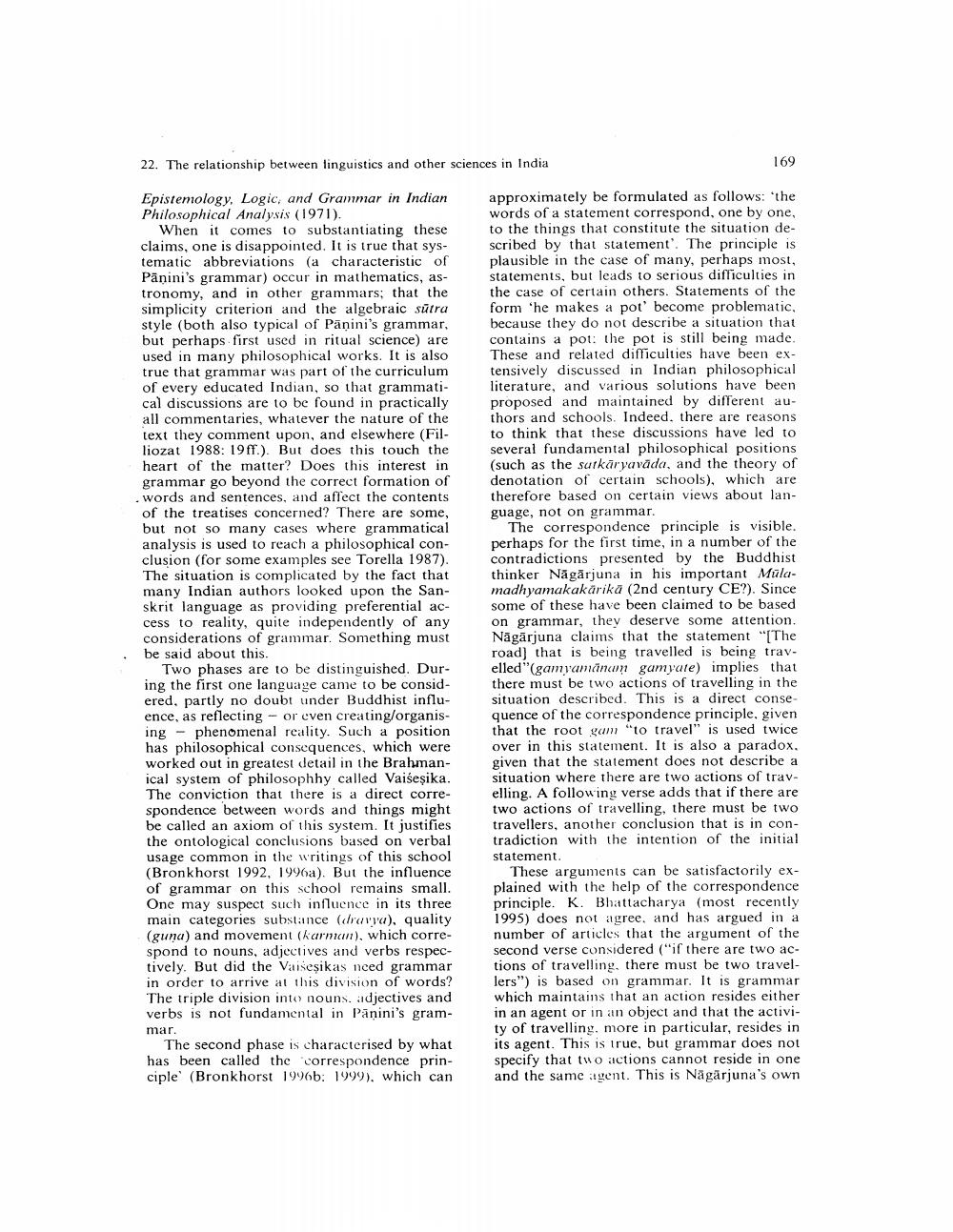Book Title: Relationship Between Linguistics And Other Sciences In India Author(s): Johannes Bronkhorst Publisher: Johannes Bronkhorst View full book textPage 4
________________ 22. The relationship between linguistics and other sciences in India Epistemology, Logic, and Grammar in Indian Philosophical Analysis (1971). When it comes to substantiating these claims, one is disappointed. It is true that systematic abbreviations (a characteristic of Panini's grammar) occur in mathematics, astronomy, and in other grammars; that the simplicity criterion and the algebraic sūtra style (both also typical of Panini's grammar, but perhaps first used in ritual science) are used in many philosophical works. It is also true that grammar was part of the curriculum of every educated Indian, so that grammatical discussions are to be found in practically all commentaries, whatever the nature of the text they comment upon, and elsewhere (Filliozat 1988: 19ff.). But does this touch the heart of the matter? Does this interest in grammar go beyond the correct formation of .words and sentences, and affect the contents of the treatises concerned? There are some, but not so many cases where grammatical analysis is used to reach a philosophical conclusion (for some examples see Torella 1987). The situation is complicated by the fact that many Indian authors looked upon the Sanskrit language as providing preferential access to reality, quite independently of any considerations of grammar. Something must be said about this. Two phases are to be distinguished. During the first one language came to be considered, partly no doubt under Buddhist influence, as reflecting - or even creating/organising phenomenal reality. Such a position has philosophical consequences, which were worked out in greatest detail in the Brahmanical system of philosophhy called Vaisesika. The conviction that there is a direct correspondence between words and things might be called an axiom of this system. It justifies the ontological conclusions based on verbal usage common in the writings of this school (Bronkhorst 1992, 1996a). But the influence of grammar on this school remains small. One may suspect such influence in its three main categories substance (dravya), quality (guna) and movement (karman), which correspond to nouns, adjectives and verbs respectively. But did the Vaiseșikas need grammar in order to arrive at this division of words? The triple division into nouns. adjectives and verbs is not fundamental in Panini's gram mar. The second phase is characterised by what has been called the correspondence principle (Bronkhorst 1996b: 1999), which can 169 approximately be formulated as follows: 'the words of a statement correspond, one by one, to the things that constitute the situation described by that statement'. The principle is plausible in the case of many, perhaps most, statements, but leads to serious difficulties in the case of certain others. Statements of the form he makes a pot' become problematic, because they do not describe a situation that contains a pot: the pot is still being made. These and related difficulties have been extensively discussed in Indian philosophical literature, and various solutions have been proposed and maintained by different authors and schools. Indeed, there are reasons to think that these discussions have led to several fundamental philosophical positions (such as the sutkäryavāda, and the theory of denotation of certain schools), which are therefore based on certain views about language, not on grammar. The correspondence principle is visible. perhaps for the first time, in a number of the contradictions presented by the Buddhist thinker Nagarjuna in his important Mulamadhyamakakärikā (2nd century CE?). Since some of these have been claimed to be based on grammar, they deserve some attention. Nagarjuna claims that the statement "[The road] that is being travelled is being travelled" (gamyamanam gamyate) implies that there must be two actions of travelling in the situation described. This is a direct consequence of the correspondence principle, given that the root gam "to travel" is used twice over in this statement. It is also a paradox. given that the statement does not describe a situation where there are two actions of travelling. A following verse adds that if there are two actions of travelling, there must be two travellers, another conclusion that is in contradiction with the intention of the initial statement. These arguments can be satisfactorily explained with the help of the correspondence principle. K. Bhattacharya (most recently 1995) does not agree, and has argued in a number of articles that the argument of the second verse considered ("if there are two actions of travelling, there must be two travellers") is based on grammar. It is grammar which maintains that an action resides either in an agent or in an object and that the activity of travelling. more in particular, resides in its agent. This is true, but grammar does not specify that two actions cannot reside in one and the same agent. This is Nagarjuna's ownPage Navigation
1 2 3 4 5 6 7 8
